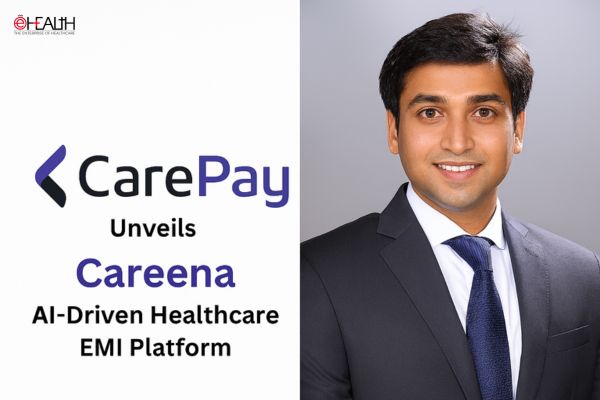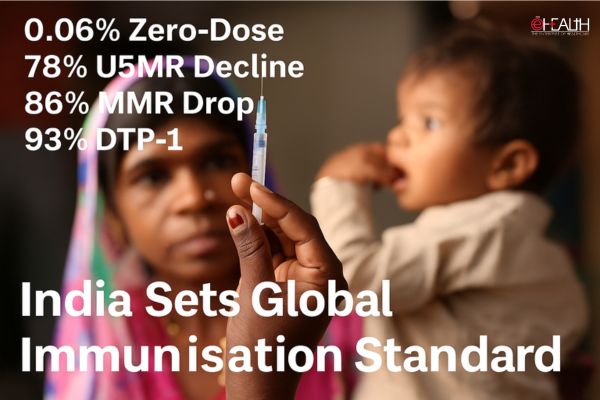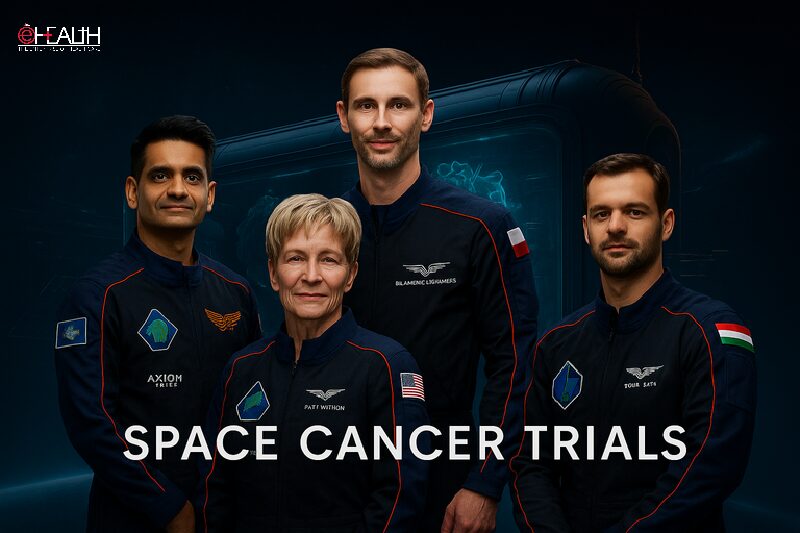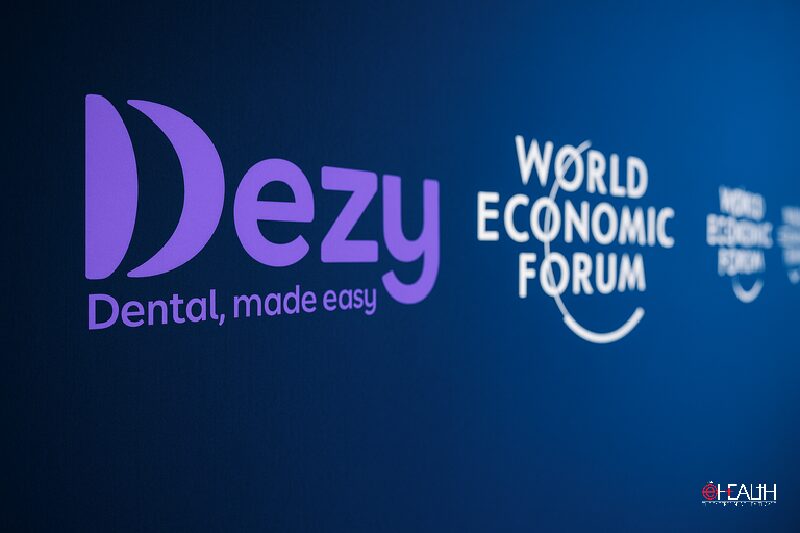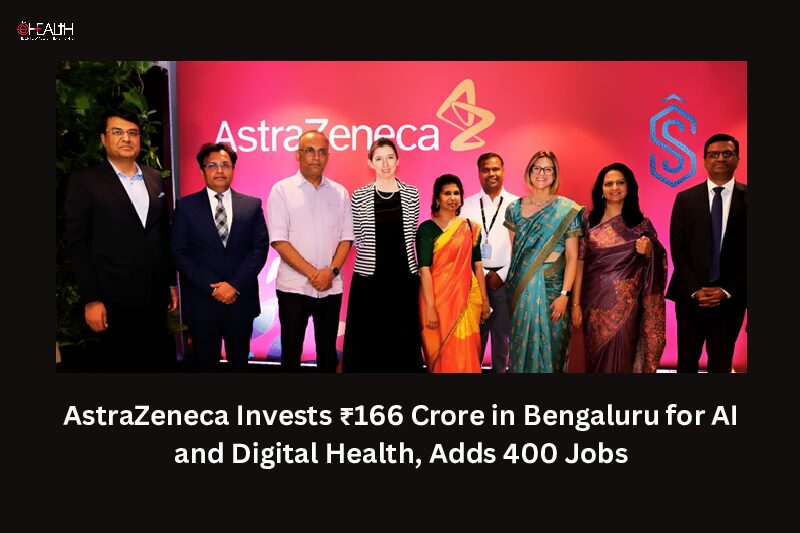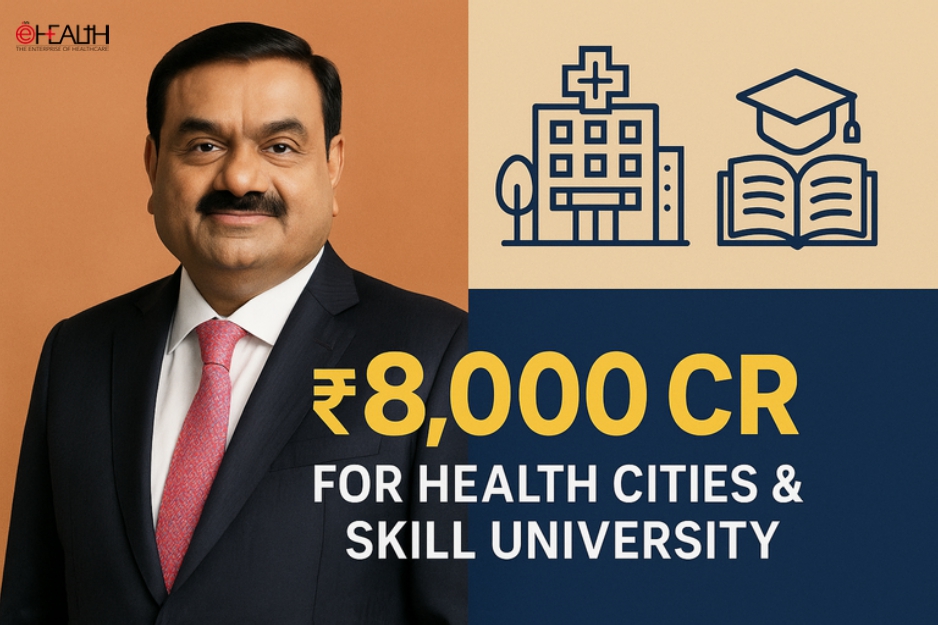
In an endeavour to deliberate upon various aspects of the Indian Healthcare delivery system including existing challenges amidst Covid-19 and how technology and innovations could help to bridge infrastructural gaps, Elets Technomedia organised the Healthcare Transformation Summit recently.
The two-day virtual summit’s objective was to how to be future ready to deal with Covid-19 like challenges, optimizing existing resources and leveraging digital technologies.

The Summit which witnessed presence of a galaxy of healthcare luminaries i.e top policymakers, international experts, industry players, and hospital decision-makers, disseminated information regarding latest trends and practices, skills and resources, and create channels for collaboration and consensus among key stakeholders.

The experts discussed at length on how covid-19 has changed the whole narrative of delivery of healthcare and other various prominent issues influencing the sector.

The policymakers and experts who graced the occasion include Shri Ashwini Kumar Choubey, MoS, Ministry of Health and Family Welfare; A L Hek, Hon’ble Minister of Health & Family Welfare, Home, Art & Culture, Government of Meghalaya; Shri Satyendra Jain, Hon’ble Minister of Health & Family Welfare, Power, PWD, Industries & Gurudwara Elections, Government of NCT of Delhi; Dr Vipul Aggarwal, Deputy Chief Executive Officer, Ayushman Bharat – Pradhan Mantri Jan Arogya Yojana (AB – PMJAY), Government of India; Abhishek Kumar, Executive Director-IT, Ayushman Bharat – Pradhan Mantri Jan Arogya Yojana, National Health Authority(NHA); Professor Sarman Singh, Director and CEO, All India Institute of Medical, Sciences, Bhopal; and Dr Atul Mohan Kochhar, Chief Executive Officer, National Accreditation Board of Hospitals (NABH).

Also read: HAI in the COVID-19 Era: Is there any Sustainable Solution for Airborne Infections?
The theme of the summit was ‘Adapt and Rise: Combating COVID-19 with Systematic Resilience’ where policymakers and luminaries would deliberate upon how to do away with ongoing pandemic and make our system ready for any such future challenge.
Other important topics, on which healthcare stalwarts threw light include ‘From Crisis to Care : Impact of COVID 19 on Infection Control and HAI’, ‘Hospital Infrastructure: New Challenges and Opportunities’, ‘New Digital Health Disruption in Post COVID-19 Era’, and ‘Role of IT in Healthcare Transformation’, and ‘Ensuring a Scientific Approach to COVID-19 Management: Significance of Streamlined Medicine Accessibility.
On this occasion, a special issue of eHealth magazine was also released. Healthcare leaders, who have been creating a difference in the paradigm of delivery of care, were also recognized.
A brief report of what experts said on the occasion:
Inaugural Session
Shri Ashwini Kumar Choubey, MoS, Ministry of Health and Family Welfare Launch of Special eHealth Edition & Presentation of Healthcare Excellence Awards

Health is biggest wealth one could have. One should focus on to keep himself healthy. Today digital technology has seeped in to every sector. Digitalization has played a key role in improving delivering of services. Since 2014, we have been focusing on many such initiatives including Digital India, Making India, and Startup India. Government’s objective is to make self sufficient (Aatam Nirbhar) India. Covid-19 has brought whole world to its knees. Due to strategic move of lockdown and other measures by visionary leadership, covid-19 unleashed minimum damage to India. We have one of the best recovery rates (74.30 percent) among affected countries. We have 12,949 quarantine centres, 11 lakh isolation beds in dedicated covid-19 hospitals, more than 40,000 ICU beds to tackle Covid-19 patients. Initially we struggled for ventilators. We aim to create 75,000 ventilators and export to other countries.
A L Hek, Hon’ble Minister of Health & Family Welfare, Home, Art & Culture, Government of Meghalaya

We were the first state which declared lockdown to combat the Covid-19. Self discipline is only solution to control the pandemic. We made citizens and healthcare staff to follow guidelines and protocols religiously– like hand hygiene, wearing mass and social distancing norms. We have been conducting rigorous testing in districts especially at entry and check points. We have more than 700 covid management committees, headed by traditional heads like panchayat. All are working in tandem to defeat the pandemic. We are making people aware and providing trainings on how to protect themselves. At present, we have 155 quarantine centres and 3,492 beds, and 28 corona care centres.
Shri Satyendra Jain, Hon’ble Minister of Health & Family Welfare, Power, PWD, Industries & Gurudwara Elections, Government of NCT of Delhi

We strategized to provide better care to covid-19 patients. Our objective was to control mortality and for that we worked on those patients having co-morbidites like diabetes, heart issue and all. We segregated covid-19 patients on the basis of severe covid-19 cases–home isolation for moderate cases and hospital beds for severe patients. We created holding area in every hospital-you will be admitted first and all formalities would be done later on. All ambulances were equipped with emergency facilities. We created plasma bank which helped covid patients to get antibody from recovered patients. With these efforts, Delhi is now moving towards herd immunity. But we need to be cautious and must not be complacent.
Panel Discussions
From crisis to care: Impact of COVID 19 on Infection Control and HAI

Dilip Patil, Co – Founder & Director, Trivector Group & Baby Quest Cryobank
Infection control is the major focus area today amidst Covid-19. It is paramount to control the infection in order to keep diseases at bay. Hand washing, surface cleaning, and tacking air borne impurities are among top measures which could help us to get protected against infection. Corona virus spreads through droplets in air. Air borne impurities are major culprit. Though hospitals have precautionary measures in place, but those are not enough. New tech solutions should be sustainable and safe for patients. Our solution has been tested and validated for covid-19. It kills corona virus upto 99 percent.
Dr. Tamorish Kole, Chairman, Medeor Institute of Emergency Medicine, Medeor Hospitals
Infection control which was seen as an issue of only the healthcare providers or hospitals, but now the scenario has changed with the pandemic. Lot of technological solutions are emerging that have initiated a new norm. Usage of antibiotics should be restricted and the doctors should give an explanation why it is used. It should be used very cautiously particularly the restricted ones and in many hospitals clinicians take decision on their own, which is not appropriate consultation and the team of specialists between incentive microbial and infection control specialists is necessary.
Dr. (Prof) Anant Kumar,Chairman – Uro-Oncology Robotics & Kidney Transplantation, Max Healthcare
We use to enforce about hand hygiene but it was not taken seriously but now with this virus patients learnt the importance of it and this has brought in a drastic drop in the wound infection rate. The infection rate is also dropped in ICUs, wards and operation theatres. Overall hygiene standard is improving. The government should bring in strict policy. Pharma companies should not give medicine without proper prescription. We are heading towards a disaster that needs to be addressed.
Dr. Chandrika Kambam, Director – Clinical Services, Health Care Global Enterprises Limited
HAI has always been a topic of importance. The pandemic has brought this back into focus and attention. Hand hygiene compliance has gone upto 20 to 25 percent in the last four months, whereas normally the hospital struggles to get compliance on the same. Globally so many studies have indicated that hand hygiene alone can control so many infections. Also the mass communication on infection control is a big impact and laid a foundation for good practices that will make a tremendous change in HAI.
Hospital Infrastructure: New Challenges and Opportunities
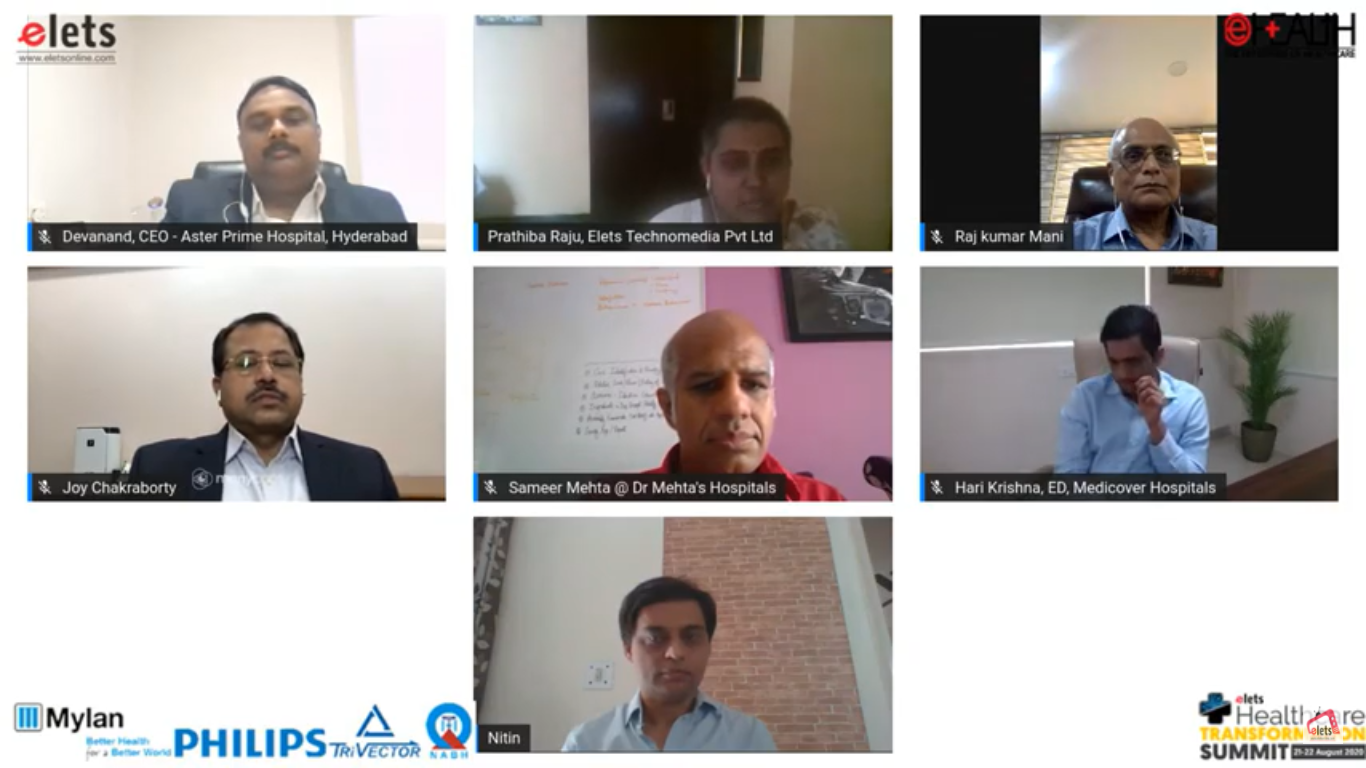
Nitin Pandey, Head HTSI, Solutions CoE, Philips India
We are in the hospital design market for more than a half decade now our market includes countries like Latin America, North America, Europe, Asia. As for India we are quite in the nascent stage till now we have delivered 2.7 billion square feet of hospital space design for different hospital clients across the country. In this pandemic situation the infrastructure challenge was segregating the COVID-19 patients and non COVID-19 patients. Philips has worked with certain hospitals’ emergency departments where one portion is isolated for mass casualties.
Joy Chakraborty, COO, P D Hinduja Hospital
This pandemic has taught us in a big way that functioning, architecture, hospital design will be the key factor for hospitals. Initially we had to create a safe room and a triage room was put in place so the hospital doesn’t get contaminated. We had a separate building and converting it into COVID-19 isolation ward was not an easy task; we had to create proper zones like red, yellow, and green, installing the HEPA filter, air circulation, and transportation of patients. It needed meticulous planning and execution.
Devanand KT, CEO, Aster Prime Hospital
During the first lockdown period when there was not much patient occupancy in the hospital we started with hands on training for the hospital staff on infection control measures, the way to stay safe and safe garbage disposal. Root maps for accessing the wards or floors were given to each staff in the hospital. We had separated the diagnostic labs and radiology departments and we had adopted different timings for the COVID-19 and non COVID-19 patients. The major challenge encountered was counselling the family of the patients with digital devices like tab and videos to update about the patients.
Sam Mehta, Executive Vice Chairman, Dr Mehta’s Hospital
As for public health set up the management of COVID-19 for each state it has been a different response many have done it differently some better than others. Private sector has been mostly the same, we are an 87 year old health system, our main hospital building was built in 1955 and we have been modifying the layout. The important observation made during COVID-19 in terms of infrastructure was not just about the patient or visitor flow it was other about how the clinician, nurses safety, garbage disposal and flow of equipment. Hospitals had to manage their strengths and weaknesses.
Rajkumar Mani, Director-Strategy and Covid-19 management, Yashoda super speciality hospitals
The COVID-19 experience is transformative and it makes us reflect what we have been doing in the last two months. I don’t think we did everything very well as we have the benefit of hindsight. We started converting hospitals into COVID-19 and non COVID-19, patients were not admitted in many of the hospitals that caused a lot of difficulty for patients. It was more important to triage properly, in our hospital we had a seven point questionnaire and properly accessed. Initially we had difficulty in ascertaining the COVID and non COVID-19 patients but now with the antigen testing that has become easier.
P Hari Krishna, Executive Director,Medicover Hospitals
We run 15 hospitals in 3 states Telangana, Andhra Pradesh and Maharashtra with 3000 beds. In Telangana, Andhra Pradesh COVID-19 peaked a little later so we were able to see the other models. Out of 15 hospitals we converted one into COVID facility in Hyderabad. As of today we are treating 1000 COVID-19 patients and have already treated over 4000 suspected COVID patients in the past three months. We created an executive board particularly to tackle the pandemic. Lot of learning was done before initiating the COVID management. We had created different zones, triage areas, separate entry points and created an internal video conferencing app.
New Digital Health Disruption in Post COVID-19 Era
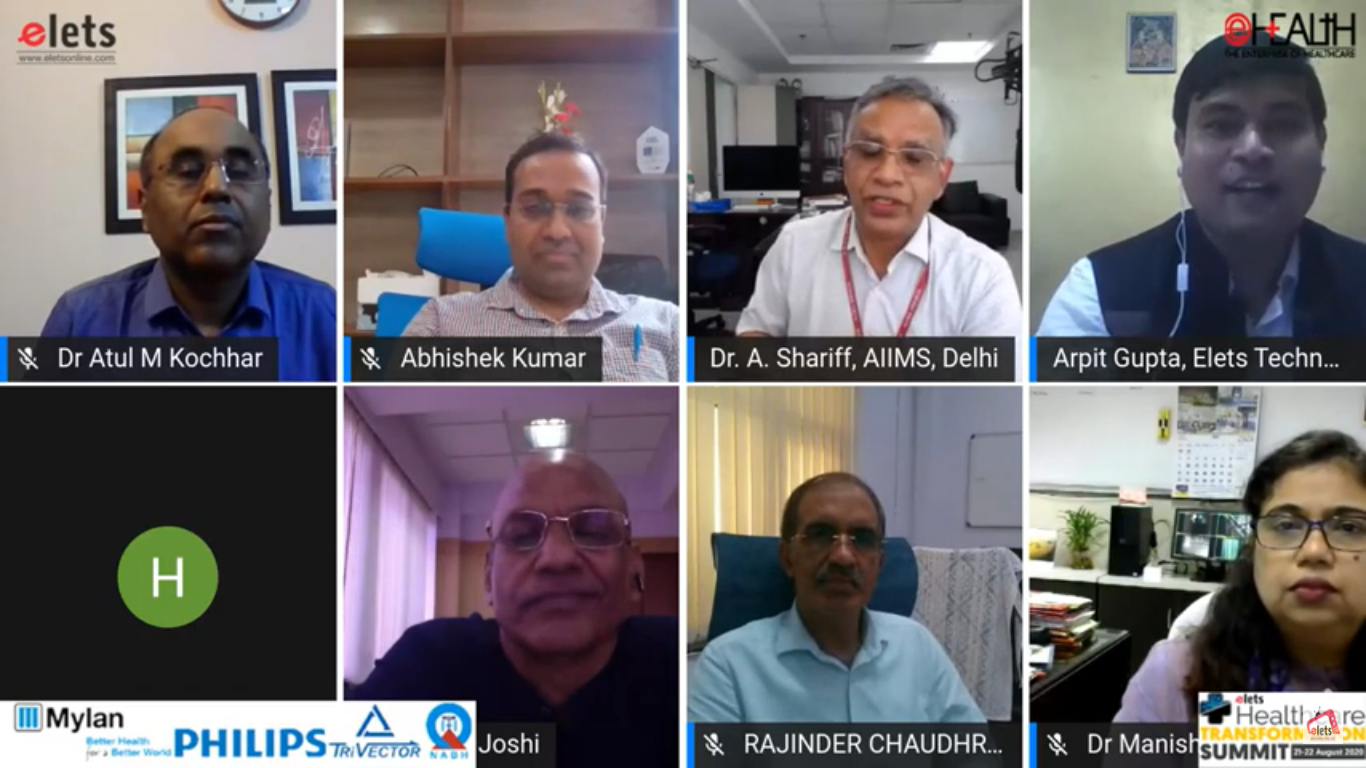
Rajinder Chaudhry, Chief Media, Ministry of Health & Family Welfare, Government of India
Any scheme of the government can’t get desired success unless people use various provisions of it or they were made aware of the same. Covid-19 has been a great example that how an awareness campaign is integral for successful implementation of any scheme. Mass awareness is needed and its holds true for NDHM. Awareness about the scheme should be known to all the beneficiaries and stakeholders, then only it could be effectively implemented.
Abhishek Kumar, Executive Director-IT, Ayushman Bharat – Pradhan Mantri Jan Arogya Yojana, National Health Authrority (NHA)
NHA has been entrusted to implement National Digital Health Mission. Covid-19 has exposed challenges in our healthcare delivery system. NDHM will be going to revolutionize our healthcare system. For any digital system to work well, we need two basic requirements—all the stakeholders involved in the healthcare ecosystem must be clearly identifiable in the system and interoperability. Healthcare ecosystem is so fragmented that all the applications, services, and stakeholders are working in silos. We don’t have any integrated system. Most of the health records are in paper form presently which must to be digitalized for easy accessibility.
Also read: The Covid-19 pandemic and your Heart
Dr Atul Mohan Kochhar, Chief Executive Officer, National Accreditation Board of Hospitals (NABH)
The Digital disruption offers huge opportunity. Digital technology, upgradation, and introduction of tele health in a big way is a good silver opportunity that has been provided to us during the covid times. In future, a significant portion of the healthcare will be telehealth that includes teleconsultations, mhealth, and all issues of security, privacy. With new technology, lots of responsibility also comes. This digital disruption will help us to take technology to masses. NDHM will revolutionize the face of healthcare delivery in India.
Dr D C Joshi, Senior Advisor, Board of Governors, Medical Council of India
There is no doubt that health is one sector where digitization will help to streamline things. Digitisation has proved its might in banking and other sectors. In healthcare, it is at rudimentary stage. Though government has done undertaken measures, enabling people to check availability of beds, ventilators and all, lots need to be done. Information should be readily available and shared among all the healthcare facilities. Digitization has been done in the government sector, private sector lags behind. They have their internal system, but we don’t have any mechanism where we have coordination and synergy among all facilities.
Dr Manisha Shrivastava, Medical Superintendent, All India Institute of Medical Sciences (AIIMS), Bhopal
When Covid knocked we were little prepared for it. The reason being the Government had already implemented Ayushman Bharat initiative and undertaken many digital initiatives like telemedicine. Stage was already set. RT-PCR is complicated test to be carried out in any setting. Contract tracing, patient tracing, sending them to covid centres, home isolation, have been managed beautifully. ICMR has managed record number of testing in the span of five six months. Digitization has played a key role on these fronts.
Dr A Shariff, IT Head, All India Institute of Medical Sciences (AIIMS), Delhi
When covid-19 hit, we put together lots of in-house solutions. IT is way to go. Centre has undertaken many measures recently like telemedicine guidelines and national Digital Health Mission, which will prove gamechanger in coming years. Covid-19 has accelerated the adoption of IT in healthcare. NDHM is great move but logistic challenge is privacy and safety of data. Addressing these aspects would be key challenge while implementing the initiative across the country.
Role of IT in Healthcare Transformation

Dr Vipul Aggarwal, Deputy Chief Executive Officer, Ayushman Bharat – Pradhan Mantri Jan Arogya Yojana (AB – PMJAY), Government of India
Ayushman Bharat is world’s largest public funded health insurance scheme launched in 2018. It provides health cover of Rs 5 lakh/family/year. It covers all the secondary & tertiary care hospitalization including covid-19 testing and treatment. It is entitlement based scheme. We have empanelled 23,000 private and public hospitals. 31 States/UTs have converged or implementing only PM-JAY. It is becoming a national platform for other schemes to converge. It is being run through robust IT platform. We have comprehensive dashboard for beneficiary identification, portability, and to monitor state & district performance.Till date, 125cr E-cards have been issued. We have spent more than 150,000 crore on hospital admission.
Dr Raj Kamal Yadav, Mission Director, Ayush Mission, Uttar Pradesh, Special Secretary, Ayush, Government of Uttar Pradesh
IT has played a key role in augmenting delivery of services. During Corona times, its role has increased manifold. We also leveraged the technology and launched Ayush Kavach App. It is a single stop centre where one can get all information like Ayush traditional information, and yoga protocols. The App also facilitated telemedicine services. Till date, a total of 20 lakh downloads have happened. We also delivered 26,000 tele consultations. Chat based consultation was new initiative. Synergy of IT with latest initiatives would be very beneficial.
Dr K Madan Gopal, Senior Consultant (Health), NITI Aayog, Government of India
When the Ayushman Bharat was being rolled out, we thought of having a integrated software in form of health stack so hat preventive and curative care could talk to each other. Idea was that preventive data would be coming from different ministries, different programmes having personal level data and another data from PM-JAY. Initially it was an idea of having a National Health Stack which ultimately took shape in form of National Digital Health Mission blueprint. It will be rolled out soon and pilot project has been launched in few of the Union Territories. Awareness would be a major challenge. To leverage technology in best manner, it should be synchronize with existing system and processes.
Kiran Anandampillai, Advisor (Technology), National Health Authority (NHA), Government of India
NDHM offers huge opportunity to both public and private sector. It is a voluntary programme and anybody can have health ID. If you want digital copy of your health record, you should register for health ID. We are looking at architecture which is essentially user controlled, consent driven, and can be transferred to any provider. It can be accessed anywhere anytime with your consent. In phase one, we are targeting those things which have been digitalized already. It is becoming very pervasive and in near future it will be adopted on large scale in healthcare. NDHM is providing intraoperability and enabling infrastructure that will help unlock potential of digital health records.
Naresh Hasija, Associate Vice President, Mylan Pharmaceutical Pvt Ltd
We are a research-based organization. For us, integrating IT from research to manufacturing is important aspect. During Covid times, we have created digital supply chain. We are distributing Remdesivir across India. We have anti diversion law. We also have mandate from DCGI to collect patient consent form for every patient and medicine should be made available in covid hospitals. We have robust surveillance system on our distribution network. It is huge enabler. It has many applications including knowledge dissemination.
Ensuring a Scientific Approach to COVID-19 Management: Significance of Streamlined Medicine Accessibility
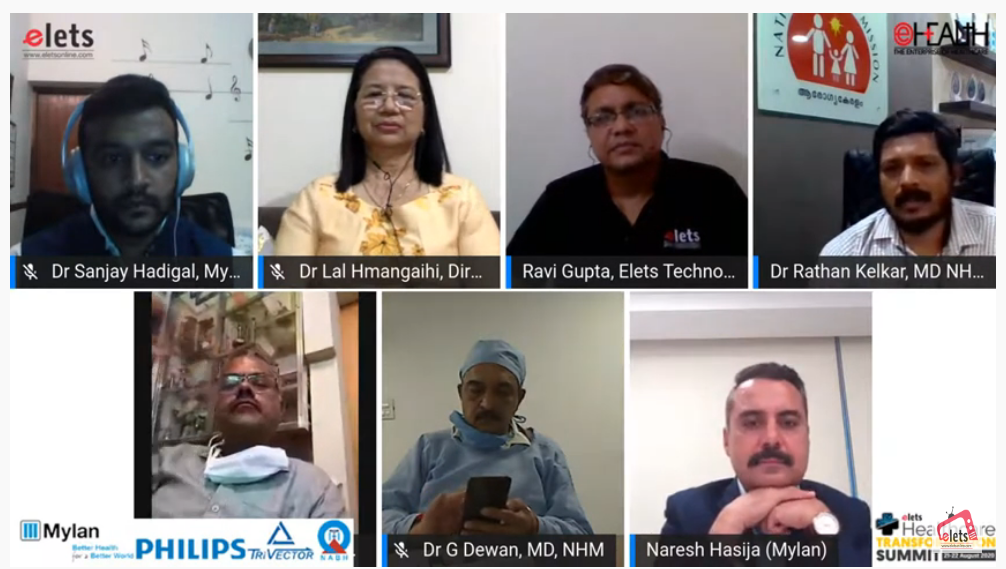
Professor Sarman Singh, Director and CEO, All India Institute of Medical, Sciences, Bhopal
The pandemic has showcased the strengths and weaknesses. Many of the medical colleges are carrying out the exams via online. The AIIMS pan India is mentoring all the medical colleges in their respective states on how to conduct exams, virtual clinical management, availability of medicines, PPEs. Every week with the Ministry of Health and Family Welfare (MoHFW), ICMR all the AIIMS conducts Centre of Excellence (CoE) webinar. As the theme of the summit Adapt and Arise I hope each institution has risen for the occasion the ICMR, AIIMS Delhi and MCI have done unprecedented to combat the virus.
Dr. G Dewan, MD, NHM and Director Health Services, Chandigarh Administration
Testing facilities are in place now. Per day we are doing about 700 antigen testing in the state.We have scaled up infrastructure to tackle cases. We also have started a door to door initiative by ANM on the line of polio campaign to detect cases among asymptomatic patients. We have made transit beds for COVID-19 patients. Home isolation facilities have also been allowed for patients having moderate symptoms. We were the first state to introduce the sticker that a family has COVID-19 patients, which was stuck outside a house so the neighbours can take preventive measures.
Naresh Hasija, Associate Vice President, Mylan Pharmaceutical Pvt Ltd
We supply our medicines to 165 countries. Our foremost importance was given to protect our staff, particularly in the factories and manufacturing facilities. Mylan is supplying remdesivir medicine directly to 15 state governments and our huge manufacturing facilities which can produce half a billion vile and we can scale it up at any moment. We make sure that essential drugs will not be of short supply. Apart from supplying remdesivir COVID-19 medicines their top priority will be concentrating on a smooth supply of other medicines for tuberculosis, viral hepatitis and HIV.
Also read: Home healthcare helping people in post COVID-19 recovery
Dr. Rathan U. Kelkar, Mission Director, National Health Mission, Government of Kerala
The pandemic has reached various stages in various states. In Kerala strategy has been to active, passive surveillance and contract tracing so that we will be able to identify index cases and try to break the chain. We are following all the COVID-19 protocols. Our main agenda was to curb public not to spread the virus and we are focusing on controlling the mortality and have various campaigns for old people and affected with co-morbidities. The state has been quite successful in curbing the spread of the virus.
Dr Sanjay Hadigal, Senior Manager, Medical Affairs, Mylan Pharmaceutical Pvt Ltd
We are scientific driven organization and have conducted educational programs via webinars related to COVID-19. The educational program discusses the real basics and various concepts of the virus, preventive strategy. We are also trying to get this module to various state health departments so they can benefit from it.
Dr. Hmangaihi Dir, Director, Medical Education & Head of Zoan Medical College, Government of Mizoram
Our state is very small state. It has very less population of 30 lakhs only and the state government is working to combat the virus. Now the main problem we face is para military forces are moving in and almost 90 percent of them are being testing positive in quarantine centres and with the borders opening up we have many truck drivers carrying essential commodities are undergoing antigen testing. We have good participation from IMA, Mizoram branch.
Dr. Heera Lal, Additional Mission Director, National Health Mission Government of Uttar Pradesh
In India the way we tackled the COVID-19 is satisfactory. If we compare ourselves to developed nations we have managed to tackle the virus well. Right now the main issue is we have been burdened healthwise and economically too in the coming six months we need to build a strategy to focus on other issues particularly other communicable and non communicable illnesses as well.
Day 2 –Panel Discussions
Rebuilding Healthier Nation: Challenges in Dealing with Pandemic Situations

Dr Vijay Satbir Singh, Former Additional Chief Secretary, Public Health Department, Government of Maharashtra
We are going through very difficult times, experiencing one of the worst episodes in human history. Covid-19 has generated an atmosphere of extraordinary challenges and uncertainty all over the world. Early warning system is must to get ourselves prepared for any such future pandemic. Then timely action and public awareness are other important things. We must have logistic planning, enough number of beds, ICU equipped with ventilators and other emergency facilities, and standard procedure of treatment.
Dwivedi, CIO, Rajiv Gandhi Cancer Institute & Research Centre
Certain countries have done very well in response to the pandemic while some other didn’t do that well. How you are dealing the situation that matters the most. Countries which responded to the situation, experienced lesser mortality and better management. Those reacted to the situation in unprepared manner, there severity was more along with chaos. Ideally there should be a strategy in place to deal with the situation in holistic manner. Basic building block—infrastructure should be there and resource should be used prudently.
Gandharv Roy, COO, MEDICA Super Specialty Hospital
Technology has enabled accessible and cheaper healthcare. In an era of IT and technology, people have easy access of data and information. Corona virus has in a way brought opportunity to work on weak areas to make the organization future ready. Telemedicine is flavor of the season now. People are seeking tele consultations for chronic diseases. Distribution of healthcare professionals is a challenge. Rural areas have laest number of doctors to tackle patients.
CEO Panel: Harnessing Healthcare Biz Beyond COVID

O P Yadav, CEO, National Heart Institute
Clinical volume has plummeted. Financial position is under stress. Beseeching the government at this stage when its coffer is empty is not going to help. We will have to take ball in our own court and tackle it. We have tried to take out the hospitality element out of the hospital, which has helped us on cost saving. Then, certain areas which were not being used, we closed them and concentrated on fixed areas with all specialties working from there rather than keeping all the areas open. We addressed concern of our staff by energizing them, decentralizing the decision making, and try to bring them on board, stating that you innovate and do cost saving.
Ravindra Karanjekar, CEO, Kiran Super Multispecilaty Hospital
Last six months have been unusually eventful. We have seen encroachment over personal and professional area by covid-19 which has changed whole perception of the healthcare. It has made us more disciplined and more aware on how we should work in better way. It brought tremendous stress to middle level hospitals as they faced financial and manpower challenges. Though government played a vital role in the whole process, coordination among various agencies was missing. Covid-19 situation brought opportunity in disguise for all the hospitals.
Dr Hiren Ambegoakar, CEO, S L Raheja Hospital- A Fortis associate
We have significant loss in first quarter when covid-19 suddenly struck. It will jeopardize almost next one year of growth. We should aim to maximize our yield. When we can’t increase revenue, analyse existing costs. We have monolithic building. We have 150-bed hospital to tackle 130 covid patients, which leaves only 20 bed for other other emergency procedures. People were afraid to come to hospital for non-covid emergency care. Now when things have improved, gradually, we will have to shift our focus from covid patient base to non covid work. We need to plan how we could go back to non covid era.
Dr Venkat Ramana Sudigali, Director & CEO, Excell Hospitals
Traditionally the hospital and healthcare provider industry thought that they would be immune to any downtrend in the nation’s economy. But this covid has caught everybody unaware and it has now proved that even the hospital industry could be severely affected by it. Hospitals are finding it tough to sustain. Normally average EBITA is 15 percent. As occupancy rate plummeted to 10-15 percent, it is difficult to attain normal EBITA for another six months. Now we need to innovate and correct our mistakes what we did in the past. Services should be more patient centric.
Dr. K. Venkataramanan, Director, Bhaktivedanta Hospital
When the pandemic started, we had a meeting with all our staff. We first attended the immediate requirements to ensure their safety as well as patients’. Then we met municipal commissioner and involved in the process of how to take care of this pandemic situation. We started creating one dedicated covid hospital where we faced many challenges including manpower issue. We motivated staff to take the pandemic head on. Initially occupancy had gone down, but it is picking up now.
How COVID-19 has redefined the health IT scenario, where are we heading

Veneeth Purushotaman, Group CIO, Aster DM Healthcare
In general the role of CIOs has evolved and it has become more consistent and they are responsible for the business outcomes and the technology. In particular, the healthcare domain is going through major transformation so the role of the CIOs is critical. Usage of telemedicine, teleradiology has become crucial during the pandemic, clinicians who were otherwise reluctant to indulge in it have used it widely. The eICU solution was helpful for the hospital workers; the technology played a significant role.
Abdullah Saleem, Group CIO, Omni Hospitals
Role of CIOs is not just technology driven there is more towards it. Due to this COVID-19 situation certain issues related to IT have been addressed pertinently be it IT budget, adoption of IT from the clinicians, and patients have changed drastically. As far as Omni hospital is concerned we had used telemedicine solutions to improve the patient experience especially geriatric community. We are also looking out for IT innovative solutions post pandemic right from EMR, patient portal, digital marketing, collating clinical data so it can help to provide quality treatment and insurance.
Shuvankar Pramanick, Chief Digital Officer, Sir Gangaram Hospital, said
The COVID-19 has proved the effectiveness of a technology in the health segment is much more meaningful now from a patient, business, consultant perspective. During the COVID-19 the usage of technology in the healthcare domain accelerated and it post pandemic this will be seen as a potential business avenue. In Gangaram telemedicine was running for the past 10 years the pandemic made us use it in a much wider way. eICUs was widely used. More than any new innovations we used the present technology smartly.
Dr. Niraj Uttamani,Medical Director, Holy Family Hospital and Medical Research Center
The connection to the patient has become easier and now CIOs are responsible to keep in place an effective management IT system which takes healthcare to the next level. Designing new technologies, innovations to add onto the existing system has become necessary so that the connect between the patients and doctors becomes easier. We have upgraded the tele-consultation facility.
Neeraj Lal, Vice President, Rainbow Children Hospital
Dealing with the mother and child care we had to be careful during the pandemic, so immediate steps were taken to switch to video consultation platforms. We consult at least 300 patients a day so 30 percent of our patients were switched to video consultation, e-prescription. Vaccination for neonates cannot be postponed, so we initiated a communication vaccination program where the hospital staff visited home to give the vaccines. HIMS are also integrated. Most of the doctors are not visiting the hospital everyday; the patients’ monitors are connected with the mobile of the doctor so they can monitor and update from home.
Covid 19 Paves New Vistas to Telemedicine

Dr Rajesh Harshvardhan, Associate Professor, Department of Hospital Administration & Nodal Officer, Sanjay Gandhi Postgraduate Institute of Medical Sciences (SGPGI), Lucknow
Initially there was tele consultation which gradually evolved into telemedicine. Today it is complete integration of technology which is driving the healthcare delivery system. Many technologies like AI and VR are conversing together. Availability of internet is far and wide today. Technology driven tools are accessible in the remotest corner of country. We have the national nodal telemedicine centre at SGPGI. But it is more of capacity building than rendering treatment. Under AB-PMJAY initiative, all the wellness centres in the districts have been connected with SGPGI for tele consultations.
Dr G V Divakar, Managing Director, Divakars Speciality Hospital
Covid-19 has brought telemedicine into full stream. It is helpful for both patients and doctors as they can connect to each other. It is more relevant during lockdown where people prefer not to visit hospitals. Government already has come up with guidelines which will further help streamline the whole process. There is a huge potential of digital platform to cater unreached in remote locations.
Dr Mervin Leo, COO, Aware Gleneagles Global Hospital
Telemedicine concept was introduced a long time ago. In 2001, ISRO with Apollo hospital group had launched a programme in remote Chittur village where remote accessibility was facilitated. Thereafter many companies started pitching in for the technology. Recently prime Minister announced NDHM where all the health parameters of an individual will be digitalized. All laboratory records, drug will be available on a single platform and doctors can easily access all records with particular ID and password. This will help to address some of existing challenges in implementing digital tools.
Dr Alok Roy, Chairman& Managing Director, Medica Superspecialty Hospital
Telemedicine is a process where consultation is initiated by a patient or a practioner to provide treatment remotely. It need not to be always video based, but it could be audio based or text and facts sharing mode. Government has come up with document where it has been authorized and legalized. It has made it possible to consult without any fear or worry. Earlier we couldn’t prescribe medicine. It is time and distance insensitive. It is safe for healthcare experts to initiate consultations process and treat without getting affected.
Sachin Grover, Head of Solutions, Indian Subcontinent, Philips India
Covid situation has driven the process of adoption of new technology. Some of the segments which have been badly affected during the pandemic are mother and child care where accessibility was big issue during the pandemic. Digital health– telemedicine has proved helpful on this front. When ICU clinicians themselves get infected, it hinders whole care process. Tele ICU has been found useful in that case. Now government has come up policy with Digital health. It clearly calls out standardized way of approaching telemedicine. All the issues have been clarified in the guidelines.
Unlocking innovations in Healthcare

Dr Sandeep Chatrath, Regional CEO & Group Medical Director, Metro Hospitals
Infection control, clinical care pathways, virtual platforms, tele-consults have gained impetus. We are right now from survival to revival approach and PPP has gained momentum. Health insurance has risen to be a very important factor. COVID has taught us that healthcare is a society’s responsibility. Access improvement with empowered digital penetration is important. ArtificiaL Intelligence (AI) looked as something should be synergised with the physicians, it improves the overall healthcare by 15 to 20 percent.
Maj. Gen. S C Pareek, Executive Director, Bhagwaan Mahaveer Cancer Hospital & Research Centre
We are treating only cancer patients and they are immuno compromised so combating the virus was a major challenge. Each patient was sent a message that only at a time of emergency they can visit hospital.
In war management and casualties we learn from the past experience similarly we need to learn from past experience and be prepared. The new technology will reduce the unconventional workforce. But before acquiring a technology we need to train our workforce to put it into best use, also the allocation of budget for health particularly for research is crucial. Digitalisation should start from Primary Healthcare Centres (PHC).
Dr Dilip Rangarajan, Medical Director, NU Hospital
We had to deal with immunosuppressed patients so our first step was to staff adequately to take care of our patients. Putting down the protocols right from screening, disinfection process, how to maintain social distancing were done. Telemedicine was of great help. We have a good backup of data and for almost eight years we have monitored the hand hygiene and stored it in the Hospital Infection Control Committee (HICC).
Dr Ashish Chauhan, Consultant, Apollo Institute of Medical Science & Research Center
This pandemic has opened up flood gates to tell us that what we are neglecting is community medicine and epidemiology. Future is all about app related approaches, telemedicine. Right usage of the health fraternity and introduction of Indian Medical Service (IMS) will take us a long way. Innovation in vaccination development, infrastructure and insurance is much needed.
Dr D K Gupta, Chairman & MD, Felix Hospital
We are investing only 1.08 per cent of GDP it is the lowest compared to many countries. The pandemic is an eye-opener that we need to increase our healthcare spending. Abided all the Indian Council of Medical Research (ICMR), Ministry of Health and Family Welfare (MoHFW) guidelines on treating the COVID-19 patients. We were using robotics only for operations purposes now I think it will be used for operational purposes as well right from infection control, to food delivery within the hospital.
Dr.Vijayabaskaran Sundararaju, Executive Director, Kauvery Hospital
We initiated the treatment protocol and it was evidence based and need based. Wi-Fi enabled thermometer and pulse oximeter was used to monitor asymptomatic patients. As far as data is concerned in the past five months alone we have analysed close to 80,000 to 90,000 CT as we have 25 radiologists across the group and from this statistical analysis we can check the disease progress and recovery pattern. Data can be used in multiple ways even if it can be used to be cost-effective.
Be a part of Elets Collaborative Initiatives. Join Us for Upcoming Events and explore business opportunities. Like us on Facebook , connect with us on LinkedIn and follow us on Twitter , Instagram.
"Exciting news! Elets technomedia is now on WhatsApp Channels Subscribe today by clicking the link and stay updated with the latest insights!" Click here!








